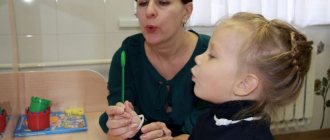Cortexin is a medicine that is used for diseases of the nervous system.
The drug is obtained from the cerebral cortex of cattle. For this purpose, the lyophilization method is used. Lyophilization is a method of obtaining peptides by freezing and drying. With this method of drug production, the biological effects of the resulting substances are well preserved. Allergic reactions to the resulting mixtures develop much less frequently than with conventional grinding of the original substrate.
A child is not a small adult. The child's body is much more complex. Many processes in it occur not linearly, but in waves. For example, height accelerates significantly during adolescence and then declines again.
Children's metabolic rate is higher. This is due to the fact that the body needs to constantly create new tissues and improve the structure of internal organs. These processes require a huge amount of energy.
Children need special medications created taking into account their anatomical and physiological characteristics.
Action of Cortexin
Cortexin is a mixture of polypeptides. After entering the body, the product is distributed throughout the body through the bloodstream.
Our body has a special formation - the blood-brain barrier (BBB). This is a set of mechanical and functional devices that regulate the metabolism between blood and brain tissue.
Due to the small size of its components, Cortexin passes through this barrier and can affect nerve structures.
The drug has the following types of effects:
- Nootropic – improves memory, attention and concentration. This occurs due to Cortexin’s ability to positively influence the mechanisms of communication of nerve cells with each other.
- Neuroprotective – increases the resistance of neurons to damaging influences: the effects of infections, toxic substances and lack of oxygen (hypoxia).
- Antioxidant – enhances the ability of nerve cells to survive in hypoxic conditions. This effect is possible by reducing the processes of fat peroxidation, during which free radicals are formed. Excessive amounts of free radicals damage cell membranes, causing them to die.
- Metabolic – improves the supply of nerve structures with nutrients and energy.
- Antiepileptic - reduces the risk of epilepsy attacks. Epileptic seizures develop due to too much stimulation of one or another part of the brain. Cortexin, due to its polypeptide nature, normalizes the ratio between excitatory and inhibitory fractions of the brain's own peptides.
about the problem
Developmental delay is a collective concept that unites a number of diseases of the nervous and other systems, in which the rate of development of the child is slower than physiological standards, when individual functions lag behind in their development from accepted norms for a given age.
The development of the motor sphere may lag behind: the child begins to hold his head up late, turns over and sits late, or starts walking late. Delayed speech development is possible when the baby begins to speak late or his speech skills and the purity of pronounced sounds suffer.
Depending on the nature of the child’s retardation, the following types of delays are distinguished: speech development delay (SRD), psychospeech development delay (PSRD), mental development delay (MDD), motor development delay (MDD), psychomotor development delay (PDMD).
The main reasons for delayed development of a child are disorders of the brain. Most often, such disorders are caused by damage to the central nervous system (PCNS) and injuries to the cervical spine received during childbirth.
During the birth of a child, a deviation from the normal course of labor may occur, which leads to instant damage to areas of the brain in the form of hemorrhages from vascular rupture or oxygen starvation of brain cells (hypoxia, ischemia) from vascular spasms. Suffered trauma to the central nervous system leads to its improper functioning and delay in the correct development of the child.
A previous injury to the cervical spine aggravates the condition of the damaged brain. Such an injury leads to displacement of the vertebrae and spasm of the neck muscles, resulting in compression of the blood vessels and a deficiency in cerebral blood flow. Under such conditions, the brain does not receive enough oxygen and nutrients it needs for normal development and functioning.
Development is also delayed by injuries and serious illnesses suffered by the child at an early age. In addition, intrauterine infections adversely affect brain development.
The reasons for delayed development of a child include the presence of certain hereditary diseases, dangerous and harmful factors of the mother’s profession, her addictions, poor environmental background, electromagnetic radiation, and the presence of an unfavorable psychological climate in which the child grows up.
In the first years of life, children with developmental delays often cry loudly for the slightest reason and have great difficulty calming down. Such children develop worse: they do not go out for walks, do not demonstrate a complex of animation when their mother appears, do not communicate with adults, and usually have an “empty” look. Later, games, cartoons, listening to fairy tales - everything that requires understanding does not arouse interest in them, or their attention is concentrated for a very short time. The speech of such children is monotonous, slurred, their vocabulary is meager, sometimes completely absent. There are disturbances in coordination of movements; these children begin to sit, stand or walk later. Sometimes their mouth is slightly open and they may drool. In the future, clumsiness of movements, frequent falls, and delays in the formation of motor skills may be noted.
Such children have poor relationships with their peers. From misunderstanding, from the inability to express themselves, children can become withdrawn, angry, aggressive, and depressed.
When such children grow up, they may complain of headaches, they often get motion sickness in transport, they do not feel well in a stuffy room, and they may experience attacks of nausea, vomiting, and dizziness.
There are often problems with intellectual development: children do not understand the meaning of speech, do not distinguish colors, do not learn counting well, and cannot learn the alphabet. Problems with fine motor skills are obvious; they cannot draw or hold a pen or cutlery correctly.
Indications for use
In children, Cortexin is used in the complex treatment of the following diseases:
- Cerebral palsy.
- Developmental disorders of learning skills, speech and language.
- Inflammatory diseases of the brain.
- Perinatal damage to the nervous system.
- Cognitive disorders.
- Attention deficit hyperactivity disorder.
- Encephalopathy.
Due to its universal action, the product can be used in all periods of the disease: from acute to restorative.
To develop a therapeutic effect, you must take Cortexin for at least 2 weeks.
More details about these diseases can be found in separate articles.
standard treatment
The first place in the treatment of developmental delay is occupied by drug therapy with drugs that stimulate brain function.
Microcurrent reflexology is a method that involves the impact of ultra-small electrical impulses on biologically active points of the brain, neuroreflex zones. Such impulses make it possible to restore the functioning of the central nervous system in those areas where it was disrupted.
To develop impaired functions, treatment courses include classes with various specialists: speech pathologist, speech therapist, child psychologist.
Physiotherapy, exercise therapy, massage (including speech therapy), hydrotherapy, and osteopathy are also used.
Alternative approaches to the treatment of developmental delays: hippo and dolphin therapy, art and music therapy, development of gross and fine motor skills, various educational games and exercises using foreign and Russian methods.
Instructions for use
Cortexin is a dry whitish-yellow powder. It must be diluted before use. To do this, use saline solution, water for injection or local anesthetic. After receiving the finished mixture, it is drawn into a syringe and injected. The injection is given intramuscularly in the buttock or thigh area.
The procedure should be carried out once a day, preferably in the morning. The course of taking the drug is 10 days. If necessary, can be repeated after 3-6 months.
You can read the instructions for use of the drug in more detail in a separate article.
cost of treatment
The cost of treatment in our center is calculated individually, depending on the severity of the disease, its duration and the presence of complications.
Each patient is prescribed comprehensive sequential treatment in the form of a course of individually selected procedures.
In addition to the procedures, the treatment course includes a free follow-up appointment.
Initial and repeat appointments, as well as medications prescribed by a doctor, are paid separately. The cost of the initial appointment is 3,000 rubles.
A 10% discount is provided for a one-time payment for a treatment course.
Analogues of Cortexin
The closest analogues of Cortexin in structure and origin are Cerebrolysin and Cerebramin.
Cerebrolysin is the closest analogue of Cortexin in origin and action. The drug is interesting because it is the very first peptide nootropic created. During its existence, vast experience has been accumulated about its effects. Compared to Cortexin, older technologies are used to obtain Cerebrolysin. Therefore, after taking it, the risk of developing side effects is higher.
Cerebramin is classified as a dietary supplement (BAA). Dietary supplements are substances that are used as an additional source of components necessary for human life. They are not medicines. This means that this category of products does not undergo the same rigorous testing as drugs, which may make them less safe and effective.
There are a number of other drugs that sometimes replace Cortexin: Mexidol, Fezam, Cavinton, Ceraxon, Pantogam. However, they have different mechanisms of action, so calling them analogues is not entirely correct. Indications for their use may differ from each other, and the combined use of drugs usually gives a more pronounced effect.
You can learn more about the differences between Cortexin and other common medications used for neurological diseases from separate articles (Links to articles).
When are injectable drugs prescribed?
Existing standards for the development of speech skills allow us to talk about significant delays only after 3 years. Until this age, it is possible to observe a speech therapist and a neurologist with non-drug correction. To do this, parents perform a series of exercises together with the child in a specialist’s office or at home.
If speech has not improved by the age of three, a diagnosis of “specific speech development disorder” may be made. It implies that the child lags behind age criteria in terms of ability to speak, but the level of intelligence and hearing is preserved and there are comfortable conditions for learning. A history of neuroinfections and injuries to the brain and skull bones was excluded. There is no cyclicity in the course of the disease.
But delayed speech development in itself cannot be an indication for the immediate start of injection therapy. The choice of technique involves monitoring the patient for at least six months and attempting correction using gentle methods. If they do not bring a positive result, drugs are added in the form of injections.
Encephabol or Cortexin, which is better for children?
Encephabol is a nootropic. The medication is available in suspension and tablets. In liquid dosage form, it can be used from birth for memory problems, fatigue, traumatic brain injury, and mental development disorders in children. The drug should not be taken if its composition is intolerant, in patients with chronic rheumatoid arthritis, if they have problems with the kidneys or liver, autoimmune pathologies, changes in blood composition. Due to treatment, the blood picture may change, nausea, vomiting, liver and kidney dysfunction, diarrhea, inflammation of the oral mucosa, fever, chills, allergies, lack of appetite, joint, headache and muscle pain, sleep disturbances and sensitivity, perversion of taste, myasthenia gravis, dizziness, shortness of breath, hair loss, nail detachment, red dermatitis.
What is better for children: Cortexin or Pantogam?
Pantogam is available in syrup and tablets. In liquid dosage form, it can be used from birth for encephalopathy, cerebral palsy, mental retardation, speech delay, stuttering, epilepsy, nervous urination disorder and some other central nervous system pathologies. Pantogam is prohibited in case of hypersensitivity to its composition or kidney dysfunction. Taking the medication may cause allergies, drowsiness, insomnia, headache, and ringing in the ears.
The doctor should decide what to replace Cortexin with, since each of these medications has its own contraindications and unwanted reactions.
Opinion of Komarovsky and other doctors
What does Dr. Komarovsky think about Cortexin? A pediatrician with many years of experience does not share the opinion that nootropic therapy is absolutely necessary.
Komarovsky points out that Cortexin does not have clinically proven effectiveness; It is generally not advisable to prescribe it to newborns and children under one year of age. The specialist pays special attention to medications for the treatment of speech disorders in patients under 3 years of age. The doctor explains that you need to treat not with nootropics, but to talk to your baby correctly and regularly.
Vast experience in using the drug, the absence of side effects and positive treatment results do not add up to the benefits of nootropic drugs. Until now, their effectiveness has not been proven through clinical studies.
Other experts claim that amino acids have a positive effect on brain cells. And when the correct dose of medication is prescribed, side effects and other problems do not arise.
What is better Piracetam or Cortexin for children?
Piracetam is a domestic nootropic drug that is commercially available in ampoules, tablets and capsules. The drug is used to eliminate the consequences of perinatal brain damage caused by intrauterine infection, oxygen deprivation, and birth trauma. The medication is prescribed for cerebral palsy, mental retardation, and mental retardation. It is contraindicated for allergies, kidney problems, depression, acute stage of hemorrhagic stroke, Huntington's chorea. Treatment may result in anxiety, hyperactivity, decreased concentration, and increased conflict.
Characteristics of the medicine
Cortexin is a peptide bioregulator. The active substances quickly penetrate the cerebral cortex, overcoming the barrier between the circulatory system and the central nervous system. The main task of nootropic medications is to stimulate the functioning of nerve cells. Cortexin is one of these medications aimed at improving metabolic processes in brain tissue. The active component of the medicine is similar to the name of the product. An additional element is glycine, an amino acid.
Cortexin is available in powder form for the preparation of intramuscular injections for children. Other forms of medication are not provided.
You can purchase the drug in dosages of 10 mg and 5 mg. Both options can be prescribed to the baby, the dose is adjusted individually.
Cerebrolysin or Cortexin, which is better for a child?
Cerebrolysin is an analogue of Cortexin in ampoules; it is sold as a solution for injection into a muscle or vein. The drug can be used from the first days of life for mental retardation, hyperactivity, central nervous system injuries, cerebrovascular accident, stroke, and depression. The nootropic should not be used if there is hypersensitivity to its composition, kidney dysfunction, or status epilepticus. Cerebrolysin can cause allergies, aggression, disturbances of consciousness and sleep, dizziness, epilepsy, convulsions, dyspepsia, lack of appetite, fever, increased sweating, headache and joint pain, shortness of breath, chills, collapse.









